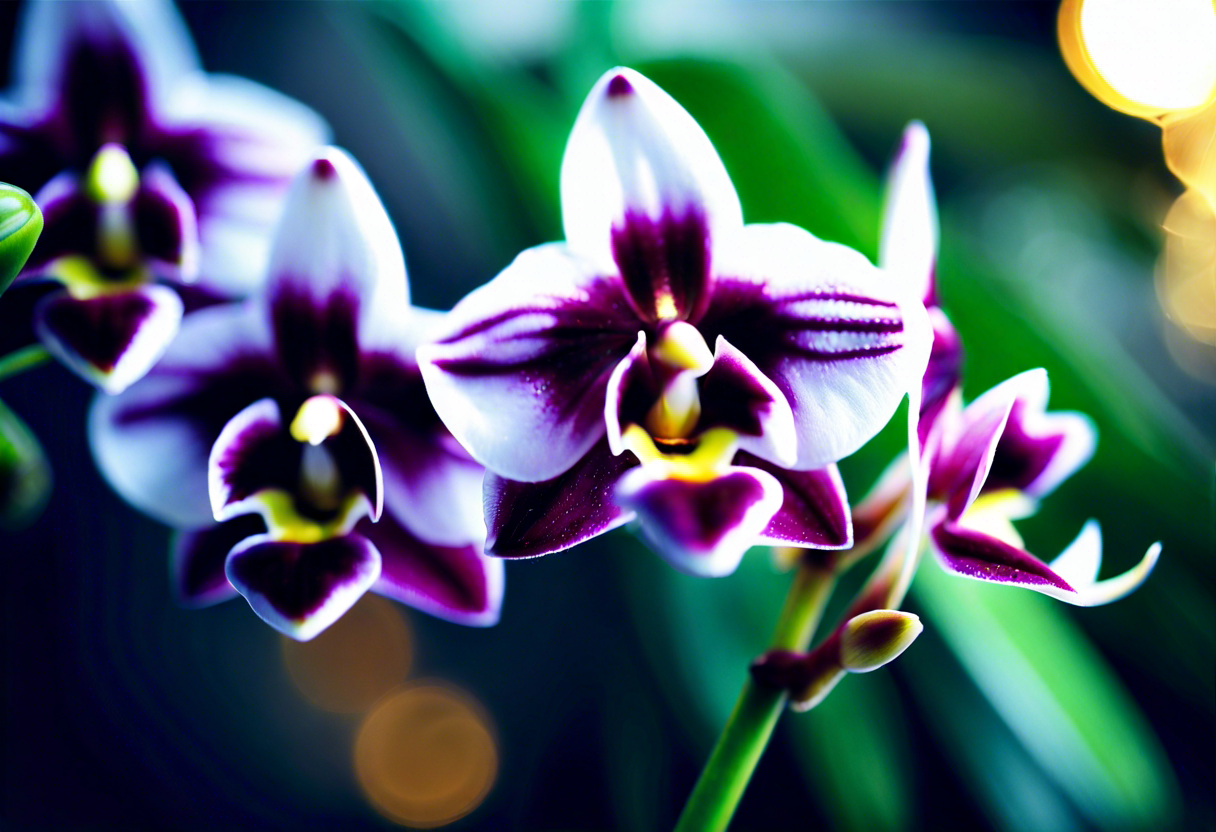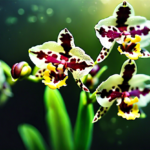Dendrobium Care Guide: Watering, Light, and Temperature Requirements
When it comes to caring for Dendrobium orchids, understanding their specific needs is essential for their health and blooming success. Proper watering, light exposure, and temperature levels play crucial roles in maintaining these beautiful plants. Here is a comprehensive guide on how to take care of your Dendrobium orchids.
Watering:
Watering is a crucial aspect of Dendrobium care. These orchids generally prefer a more specific watering routine compared to other houseplants. Allow the top inch of the potting medium to dry out before watering your Dendrobiums. It’s important to avoid overwatering, as this can lead to root rot. Water your orchids early in the day to allow any excess moisture to evaporate before nightfall.
Light:
Proper light exposure is vital for the health of Dendrobium orchids. These plants thrive in bright, indirect light. Avoid placing them in direct sunlight, as this can scorch their delicate leaves. A south or east-facing window is ideal for providing the orchids with the necessary light levels. If natural light is insufficient, you can supplement with a grow light to ensure proper growth.
Temperature:
Dendrobium orchids have specific temperature requirements to thrive. During the day, these orchids prefer temperatures between 70-85°F (21-29°C) and slightly cooler temperatures at night, around 60-65°F (15-18°C). Providing the orchids with a noticeable temperature difference between day and night can help encourage blooming.
By paying close attention to the watering schedule, light exposure, and temperature levels, you can ensure that your Dendrobium orchids remain healthy and vibrant. Remember that consistency is key when it comes to orchid care, so establish a routine that works best for your plants and stick to it. With proper care, your Dendrobium orchids will reward you with stunning blooms and lasting beauty.
Choosing the Right Potting Medium for Dendrobium Orchids
When it comes to Dendrobium orchids, selecting the appropriate potting medium is crucial for their overall health and growth. These epiphytic orchids have unique needs that differ from those of terrestrial plants. A well-draining potting mix is essential to prevent waterlogging and root rot, which can be detrimental to Dendrobiums. Here’s a guide to help you choose the right potting medium for your Dendrobium orchids.
One of the most commonly used potting mixes for Dendrobium orchids is a combination of medium-grade fir bark, perlite, and charcoal. This mixture provides excellent drainage while retaining some moisture, mimicking the orchid’s natural habitat. The fir bark allows air circulation around the roots, preventing them from sitting in water, which can cause them to rot.
Sphagnum moss is another popular choice for potting Dendrobium orchids, especially for those that require more moisture. However, it is essential to monitor the moisture levels closely, as sphagnum moss retains water more than bark-based mixes. This medium is suitable for certain Dendrobium species that prefer slightly higher humidity levels.
For enthusiasts looking for a more sustainable option, coconut husk chips or fiber can be a great alternative to traditional potting mixes. Coconut husk is eco-friendly, provides good aeration, and retains moisture well. It is a renewable resource that helps reduce the environmental impact of orchid cultivation.
In some cases, Dendrobium orchids can also be grown mounted on pieces of driftwood, tree fern fiber, or cork bark. This method closely resembles how these orchids grow in the wild, clinging to trees and rocks. Mounted orchids should be misted regularly to ensure they receive enough moisture since there is no potting medium to retain water around the roots.
When repotting Dendrobium orchids, it is essential to use fresh potting medium to provide the plants with the necessary nutrients and support for healthy growth. Repotting should typically be done every two to three years or when the potting medium starts to break down and become compacted.
By selecting the right potting medium for your Dendrobium orchids based on their specific requirements, you can ensure that they thrive and produce beautiful blooms. Understanding the unique needs of these orchids and providing them with the proper care will result in healthy, vibrant plants that will reward you with stunning displays of flowers.
Pruning and Repotting Dendrobium Orchids: Best Practices
Dendrobium orchids are prized for their vibrant blooms and exotic beauty, making them a popular choice among orchid enthusiasts. To ensure the health and longevity of your dendrobium orchids, proper pruning and repotting practices are essential. Pruning helps maintain the plant’s shape, encourages new growth, and removes dead or diseased parts. Repotting, on the other hand, allows for fresh nutrients and aeration to support the orchid’s growth. Here are some best practices for pruning and repotting dendrobium orchids:
Pruning Dendrobium Orchids:
Pruning your dendrobium orchids should be done strategically to promote healthy growth and prevent overcrowding. Start by inspecting the plant for any dead, yellowing, or diseased stems. Using sterilized pruning shears, carefully remove these damaged parts by making clean cuts near the base of the stem. It is crucial to sterilize your tools to prevent the spread of diseases among plants.
Additionally, you can trim back overgrown or leggy stems to encourage branching and a more compact growth habit. Aim to prune your dendrobium orchids after they have finished blooming, typically in the spring or early summer. Avoid excessive pruning, as this can stress the plant and inhibit its ability to flower.
Repotting Dendrobium Orchids:
Repotting dendrobium orchids is necessary to replace decomposed potting media, refresh nutrients, and provide adequate space for root growth. Repot your orchid every two to three years or when you notice overcrowding in the pot. Choose a well-draining potting mix specifically designed for orchids, such as a blend of pine bark, perlite, and charcoal.
Carefully remove the orchid from its current pot, gently shake off the old medium, and inspect the roots for any signs of rot or damage. Trim away any mushy or dead roots before placing the orchid in a slightly larger pot with fresh potting mix. Position the orchid so that the oldest pseudobulbs are near the edge of the pot to allow room for new growth.
After repotting, water the orchid thoroughly and place it in a location with bright, indirect light to aid recovery. Avoid fertilizing newly repotted orchids for the first few weeks to prevent root burn. Monitor the plant closely for signs of stress, such as wilting or yellowing leaves, and make adjustments as needed.
By following these best practices for pruning and repotting dendrobium orchids, you can help your plants thrive and continue to grace your space with their stunning blooms. Regular maintenance and care will ensure that your dendrobium orchids remain healthy and vibrant for years to come.
Common Pests and Diseases Affecting Dendrobium Orchids and How to Handle Them
Dendrobium orchids are beautiful and delicate plants that can fall victim to various pests and diseases if not properly cared for. Being proactive in identifying and treating these issues is crucial to maintaining the health and vitality of your orchids. Here are some common pests and diseases that may affect your Dendrobium orchids and how to handle them effectively.
Pests:
-
Aphids: These small insects can cluster on the new growth of Dendrobium orchids, sucking out the plant’s juices and causing stunted growth. To eliminate aphids, spray the affected areas with insecticidal soap or neem oil.
-
Spider Mites: These tiny pests are known to create fine webbing on the leaves of orchids and can cause yellowing and stippling. Apply a miticide to the affected plants and increase humidity to deter spider mites.
-
Scale Insects: Scale insects appear as small, waxy bumps on the stems and leaves of orchids. To remove scale insects, gently scrape them off with a cotton swab dipped in rubbing alcohol.
Diseases:
-
Bacterial Soft Rot: This disease manifests as water-soaked lesions on the leaves and pseudobulbs of Dendrobium orchids. Remove and destroy affected parts of the plant to prevent the spread of the infection.
-
Fungal Leaf Spot: Fungal leaf spot presents as dark, water-soaked spots on the leaves of orchids. To treat fungal leaf spot, improve air circulation around the plants and avoid overhead watering.
-
Virus: Viral infections in orchids can cause mottled leaves, streaking, and general decline. Unfortunately, there is no cure for viral infections in plants. Infected orchids should be isolated and disposed of to prevent the spread of the virus to other plants.
By regularly inspecting your Dendrobium orchids for signs of pests and diseases, you can catch and address these issues early before they cause serious damage. Maintaining proper cultural practices, such as providing adequate air circulation, proper watering, and appropriate light levels, can help prevent pest and disease problems in your orchids. Remember to quarantine any newly acquired plants to prevent introducing pests and diseases to your existing collection.
Tips for Encouraging Blooms in Dendrobium Orchids
Dendrobium orchids are prized for their stunning blooms, and with the right care, you can encourage these beauties to flourish. Here are some essential tips to help your Dendrobium orchids bloom vibrantly:
1. Provide Adequate Light: Dendrobium orchids thrive in bright, indirect light. Place them near a south or east-facing window where they can receive plenty of natural light without being exposed to direct sunlight, especially during the hottest parts of the day.
2. Maintain Optimal Temperature: These orchids prefer daytime temperatures between 70-80°F (21-27°C) and slightly cooler temperatures at night. Providing a moderate temperature fluctuation can help stimulate blooming.
3. Proper Watering Schedule: During the growing season, water your Dendrobium orchids generously when the top layer of the potting medium feels dry to the touch. Allow excess water to drain out to prevent waterlogging, which can lead to root rot. Reduce watering slightly when the plant is not actively growing.
4. Fertilize Regularly: Feed your Dendrobium orchids with a balanced orchid fertilizer at half strength every 2-4 weeks during the growing season. This will provide the necessary nutrients for healthy growth and abundant blooms.
5. Consider Seasonal Adjustments: In the fall, gradually reduce watering and allow the plant to experience a slight temperature drop to encourage blooming. Once you start to see flower spikes forming, maintain a consistent watering schedule to support bloom development.
6. Pruning and Maintenance: Remove spent blooms and yellowing leaves promptly to redirect the plant’s energy back into blooming. Repot your Dendrobium orchids every 2-3 years using a fresh potting mix to ensure optimal growth.
7. Monitor Humidity Levels: Dendrobium orchids thrive in moderate to high humidity levels. To increase humidity around your plants, place a humidifier nearby or use a humidity tray filled with water and pebbles.
By following these tips and providing your Dendrobium orchids with the care they need, you can enjoy a bounty of colorful blooms year after year. With a little patience and attention to detail, your orchids will reward you with their spectacular floral displays.
Conclusion
Dendrobium orchids into your plant collection can add a touch of elegance and beauty to your indoor space, but it’s crucial to understand the specific care requirements these unique plants need for optimal growth and blooming. By carefully attending to their watering, light exposure, and temperature preferences, you can set a solid foundation for the health of your Dendrobium orchids. Finding the right balance between watering frequency and drainage is essential, ensuring that the roots have access to moisture without becoming waterlogged. Additionally, providing ample light without subjecting the plants to direct sunlight for extended periods will help them thrive. Maintaining the ideal temperature range, with variations to mimic their natural habitat, will further support their overall well-being.
When it comes to selecting the appropriate potting medium for your Dendrobium orchids, considering factors like aeration, moisture retention, and drainage capacity is key. Opting for a well-draining medium that allows for airflow to the roots can prevent issues like root rot and fungal infections. Regularly assessing the condition of the potting medium and repotting the orchids when necessary will help maintain optimal root health and vitality. Pruning dead or damaged roots and sections of the plant during repotting is a beneficial practice that can promote new growth and rejuvenate the orchid.
Pruning and repotting your Dendrobium orchids should be approached with care and precision to avoid causing stress to the plant. By following best practices and using sterilized tools, you can effectively manage the size and shape of your orchids while stimulating healthy growth. Additionally, staying vigilant for common pests and diseases that may affect Dendrobium orchids is crucial for early detection and intervention. Implementing preventive measures and promptly addressing any issues that arise can help safeguard the overall well-being of your plants.
Despite your best efforts, Dendrobium orchids may still encounter pests or diseases such as mealybugs, scale insects, or fungal infections. By monitoring your plants regularly and implementing natural or chemical treatments when needed, you can effectively manage these challenges and prevent them from spreading. Maintaining good air circulation around the plants and ensuring proper hygiene practices can also contribute to reducing the risk of infestations or infections.
To encourage your Dendrobium orchids to bloom prolifically, providing adequate light, temperature fluctuations, and humidity levels is essential. Mimicking their natural growing conditions through temperature differentials between day and night periods can stimulate flower production. Additionally, adjusting their light exposure and maintaining consistent moisture levels during the growing season will support the development of vibrant and long-lasting blooms. With proper care and attention to their specific needs, your Dendrobium orchids can reward you with stunning displays of colorful flowers year after year.


